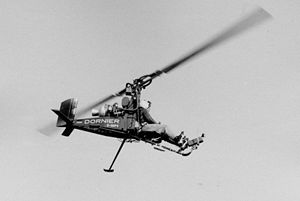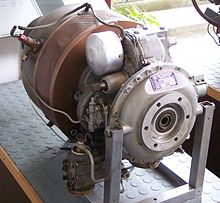Dornier Do 32
| Dornier Do 32 | |
|---|---|
 Do 32 climbing |
|
| Type: | Light helicopter |
| Design country: | |
| Manufacturer: | |
| First flight: |
3rd July 1962 |
| Commissioning: |
Never put into service |
| Production time: |
Was never mass-produced |
| Number of pieces: |
4th |
The Dornier Do 32 was a single-seat, collapsible military helicopter from 1962 by the German Dornier-Werke . It was created on the basis of a military requirement that a single-seat helicopter should be introduced into the army at company level for communication purposes.
This helicopter was supposed to be folded in a transport trailer pulled by a Bundeswehr off-road vehicle. If necessary, it should be easy to assemble. Another essential requirement was that the training of a pilot should be comparable to that of a motorcyclist in terms of duration; so that only one came leaf tips - reaction engine in question, which no torque compensation required by the pilot. In order to avoid complicated navigation training, the pilot should orientate himself exclusively on roads and railways.
Initially, the troops were required to procure 1,000 helicopters. The number was reduced several times, most recently to 350. Then the army gave up on this project. Neither a development order nor a series order was placed with Dornier-Werke, which started development at its own risk.
Description of the helicopter
drive
The design was characterized by its relatively simple and clear structure. A small, with fuels of all kinds to be operated BMW - gas turbine with mounted air compressor, type 6012 L (now MAN Turbo 6012) of about 74 kW (100 hp) and 440 N residual thrust delivered the air for the so-called "cold" blade tip drive . It was fed through hoses and the hollow rotor head into the two equally hollow rotor blades, where it emerged from rearward-facing nozzles at the blade ends and, through its recoil, set the rotor in motion according to the principle of Segner's water wheel . Since there was no retroactive torque on the fuselage, the tail rotor , which is otherwise necessary on most helicopters, was unnecessary . Control around the vertical axis was taken over by a rudder located in the exhaust jet of the turbine , which was made of high-strength steel because of the heat stress . The control around the other two axes took place in the usual way by swiveling the rotor circle plane with the help of a control stick hanging down from the rotor head . However, this corresponds to a shift of the point of application of the weight force (commonly known as the center of gravity) of the helicopter body including the pilot away from the center of the rotor circle.
The rotor
The blades of the double-bladed rotor with a symmetrical profile consisted of a drawn light metal profile tube, in the interior of which the air flowed to the blade ends. Since this compressed air was quite warm, there was no risk of ice forming on the rotor blades. While this light metal profile tube took up about the front half of the wing profile , a light, glued sandwich honeycomb construction formed the rear part of the blade profile.
Compared to other helicopters, this construction was a little heavier, but on the other hand it had a great advantage with the rotor running : Thanks to the high stored energy due to the larger rotating mass, an autorotation landing was less dangerous with the Do 32 than on most other helicopters. This was also evident in a relatively small danger zone (dead man's curve), which reached from 10 to 25 m in height and from 0 to 25 km / h. Avoiding them was expressly required in the flight manual only by inexperienced pilots.
The large rotating mass of the rotor also enabled the Do 32 to perform particularly impressively in demonstrations, the so-called jump start. If the rotor on the ground was brought to the maximum permissible speed of 500 rpm with the blade adjustment lever pressed, you could jump into the air at up to 7 m / s. If the rotor speed had dropped to the normal value of around 400 rpm, the machine had already reached a height of 30 to 40 m.
The cell
All components of the Do 32 were supported by a light tubular steel frame to which the engine , the pilot's seat, the vertical stabilizer and the three legs of the landing gear were attached, each of which had a sliding shoe at the end. At the upper end of the mast-like middle part, in which the fuel tank was housed, sat the tiltable rotor head , which was moved by the hanging control stick. The control also included the usual collective pitch lever on the left side of the driver's seat, to which the radio was attached as a counterbalance. The flight monitoring devices were attached to the front landing gear leg so that they were easy to read. All of the larger parts could be folded up so that the entire helicopter could fit into its transport box with external dimensions of 380 × 85 × 101 cm.
Construction and testing
A total of four Do 32 helicopters were built, three of which have flown. They were marked with:
- D-HOPA (V-1)
- D-HOPF (V-2)
- D-HOPS (V-3)
provisionally admitted to traffic. However, all three were destroyed during testing. The fourth, the V-4, went to the German Museum in Munich, where it was fictitiously given the license plate that the V-1 had worn (D-HOPA). The four aircraft did not have serial numbers.
Before the flight test, a complete helicopter was subjected to a 100-hour test run in a test bench with protective grids around it, during which all functions of the drive and control system were constantly checked and the values were measured and recorded using various measuring methods. The fuel supply was constantly replenished from outside by an electric pump in order to achieve longer running times than would have been possible with the fuel tank's content, which only lasted around 45 minutes. After this stand test, the helicopter was completely dismantled and all parts examined for wear and tear and any cracks. No damage was found and after reassembly the helicopter used was ready to fly again.
The first flight of the V-1 took place on July 3, 1962 , after 4 flights had previously taken place with a helicopter tied to the ground with only about 0.5 m height clearance. After 204 flights in which every conceivable operational case and all operational limits were tested and examined, the V-1 helicopter fell victim to a take-off accident, with the pilot seriously injured.
The testing was continued with the other two helicopters, whereby several landings were made on the opened transport box lying on a truck trailer. A flight up to 1500 m also took place. The second helicopter was lost during an autorotation landing when the right landing gear sank into the soft ground of the landing site and the helicopter, which is very sensitive in the controls, tilted to the left when attempting to take it off again to get to a somewhat firmer ground. The third loss occurred when trying to fly the foremost possible center of gravity . With two iron weights attached to the front undercarriage tube in a non-ejectable manner, this condition proved to be no longer controllable, so that a fall was inevitable.
Soon afterwards the client's interest also died and the development was stopped.
Final remark
The Do 32 with this drive principle had predecessors. The first was the WNF 342 helicopter developed by Fritz von Doblhoff together with Theodor Laufer in 1943 . After the end of the war, Theodor Laufer went to SNCASO in France, where he designed the helicopters SO 1100 "Ariel" and SO 1221 "Djinn" . The Bundeswehr also bought 6 of the latter for testing purposes. After returning to Germany, Theodor Laufer designed the Do 32 at Dornier. Based on its propulsion principle, the Do 34 rotor platform and the Do 132, a project for a five-seater liaison helicopter, emerged a little later . The P 406 crane helicopter project was also based on this drive principle.
Technical specifications
| Parameter | Data | |
|---|---|---|
| Dimensions | Main rotor diameter | 7.5 m |
| Length of the trunk | 3.2 m | |
| Landing gear track | 2.06 m | |
| height | 1.89 m | |
| Weights | Empty mass | 151 kg |
| Total mass (normal) | 290 kg | |
| Overload mass | 320 kg | |
| Services | Top speed in level flight | 110 km / h |
| Recommended cruising speed | 80-90 km / h | |
| Rate of climb at 60 km / h | 2 m / s | |
| Max. permissible rate of climb at jump start | 7 m / s | |
| Summit height at 70 km / h | 3000 m | |
| Summit height in hover | 300 m | |
| Duration of flight at full throttle | 38 minutes | |
| Range here | 66 km | |
| Rotor speeds | Normal range | 400-470 / min |
| Total area | 370-500 rpm |
See also
literature
- From the box . In: Der Spiegel . No. 19 , 1963, pp. 88 ( online ). Quote: "Managing Director Silvius Dornier:" Anyone who wants to crash our helicopter has to do a lot. ""
Web links
Individual evidence
- ↑ Dornier, Do 32 E, 1962. Deutsches Museum, accessed on May 20, 2012 .

